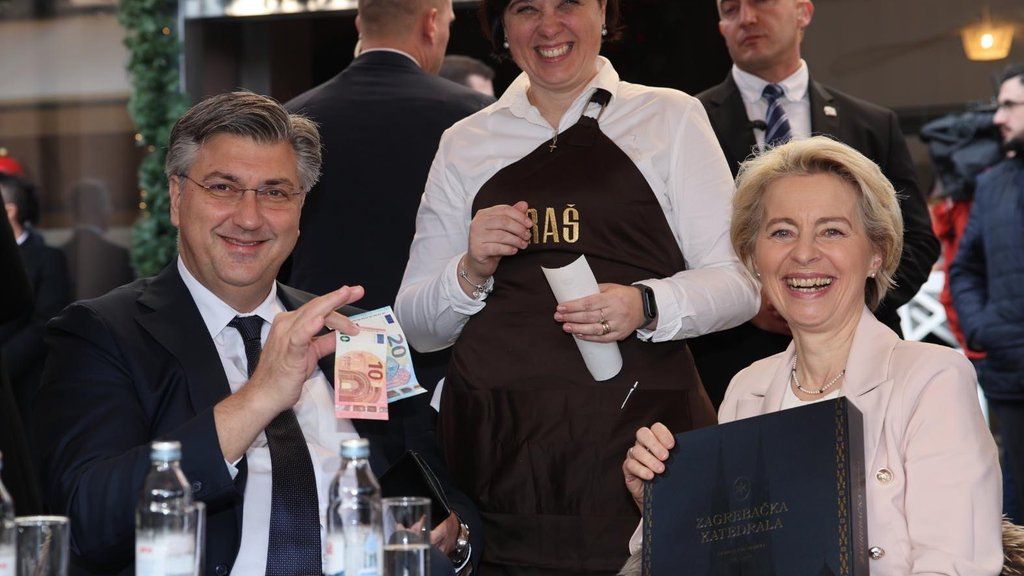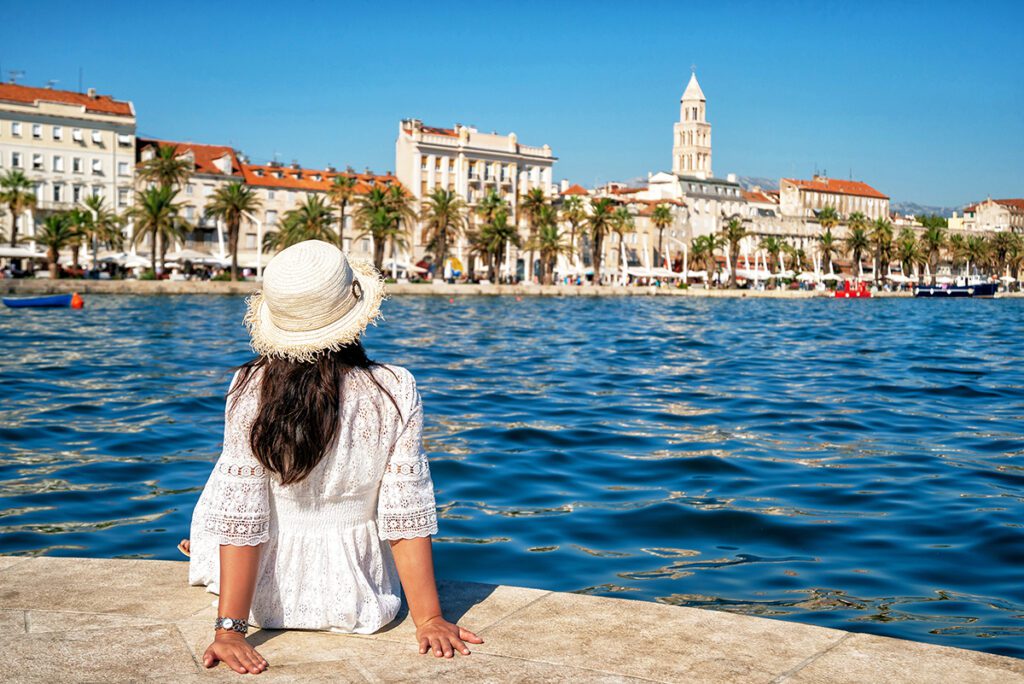
Croatia Officially Joined the Schengen Area Bloc and Now Uses Euros.
by Heather Cassell
“Today Croatia joins the Schengen area and the eurozone, two immense achievements for the youngest member state of the European Union and both reached on the very same day. So indeed, this is a day for the history books.”
European Commission President Ursula von der Leyen
It’s going to be easier than ever to visit Croatia this year.
The popular vacation destination rang in 2023 officially joining 26 other countries that belong to the Schengen area bloc and eurozone switching its currency, the kuna, to the euro. It is the first country to make the switch on the same day and year in history.
The Schengen area is now the largest border-free area in the world. Croatia is the 23rd of the 27 European countries to belong to the Schengen area which allows around 420 million European citizens to travel freely around the EU. Iceland, Liechtenstein, Norway, and Switzerland are also part of the Schengen area.
Croatian Prime Minister Andrej Plenković and European Commission President Ursula von der Leyen marked the historic moment with a ceremony at the Bregana border crossing with neighboring Slovenia at midnight January 1.
Plenković praised the “historical moment.” Von der Leyen hailed it as “a day to celebrate.”
“We are the first country to enter Schengen and eurozone on the same day,” Plenković said Sunday night.
“If there are historical moments, special moments which should provide us with great honor and when we witness the achievement of strategic goals of a state – this is such a day,” he continued.
Von der Leyen agreed with Plenković, stating, “Today Croatia joins the Schengen area and the eurozone, two immense achievements for the youngest member state of the European Union and both reached on the very same day. So indeed, this is a day for the history books.”
Police took down signs and lifted the barrier for the last time ending border checks at midnight. The former barriers were replaced with a sign reading “free passage” after the last driver to have their passport checked on the Croatia-Slovenia border was handed a congratulatory teddy bear, reported Euronews.
Finance Minister Marko Primorac and National Bank Governor Boris Vujčić took out their first euros from a Croatian cash machine right after midnight.
Plenković and von der Leyen also marked the occasion touring Croatia’s capital, Zagreb, and buying coffee at a café with euros while von der Leyen applauded him, reported Reuters. It was a long road for Croatia to see this historic moment happen.

Hot Destination
Croatia welcomed nearly 19 million tourists in 2022, a 37% jump from 2021, Croatia’s Ministry of Tourism and Sports announced January 1.
Croatia is across the Adriatic Sea from Italy at the Central and Southeast Europe country point of Europe. The Western Balkan country with more than 4.1 million Croats or Croatians is blessed with scenic pebble beaches that stretch more than 1,000 miles along the coastline with crystal-clear waters. It also features more than 1,000 islands and islets, including the famed Dalmatian coast and islands that run parallel to the coast.
Croatia entered the European Union in 2013, the youngest member state of the union. The tertiary sector, which includes tourism and hospitality, is Croatia’s top industry making up 70% of the economy, according to Global Tenders. Tourism makes up about 20% of the sector raking in around $13.8 billion (€13 billion) in 2022, reported Croatia Week. Other Croatian top sectors include agriculture (6%) and industry and manufacturing (25%).
Slovenia, which is right above Croatia, became a member state of the EU. in 2004. In 2007, the Southern Slavic country became a part of the Schengen Area and adopted the Euro.
Tourism is up in a big way in Croatia jumping 27% growth, compared to the same period in 2021. Croatia Week reported compared to the third quarter of 2019, income from foreign tourists in the third quarter of 2022 is 28 percent higher than in the same period of 2019. However, the figures aren’t back to the Slavic country’s record year in 2019 when it welcomed 21 million travelers. Among those visitors were nearly 800,000 from the country’s biggest markets Germany, Austria, Poland, Czechia, Slovakia, and the Netherlands in 2019. Yet, Croatia’s eyes are on the prize getting to pre-pandemic levels of tourism.
“In 2023, our goal is the complete recovery of tourism, the achievement of pre-pandemic tourism results at the level of the entire country, and an even stronger dispersion of tourist traffic in the pre- and post-season, said Croatian Tourist Board DirectorKristjan Staničić told Croatia Week.
“We will emphasize the promotion of Croatian islands, the hidden pearls of the Croatian tourist offer in the interior of the country, luxury offer, gastronomy, but also all those tourist products that generate tourist consumption throughout the year,” he continued.
Minister of Tourism and Sports head Nikolina Brnjac added the board’s focus this year “remains on quality, sustainability, and innovation.”
Minister Brnjac hopes that staying true to these pillars will signal that “the successes of tourism are long-term and additionally contribute to the overall economic and social development of Croatia,” she told Croatia Week.
Here is what vacationers need to know when visiting Croatia this year:

Free to Cross the Boarder
Travelers planning to visit Croatia this year will be able to easily cross over land and sea borders into the Balkan country as of January 1. The long lines waiting to cross the border from Slovenia and Hungary and on sea crossings from Italy to Croatia should lessen.
Schengen area air travel will open March 26.
Croatia is now able to issue Schengen visas to travelers.
Travelers staying beyond 90-day visa-free travel within the Schengen area won’t be able to simply travel to Croatia to wait out the 90 days until they can return to the European countries covered by the agreement. They will have to find another European country that is not a part of the Schengen area.
Good options for expatriate travelers seeking to return to the Schengen area once their visas are reset are:
- In the EU: Bulgaria, Cyprus, Ireland, and Romania. These countries are EU member states that are not part of the Schengen area.
- European countries that are non-EU members or part of the Schengen area: Albania, Bosnia and Herzegovina, Montenegro, North Macedonia, and Serbia.
Bulgaria and Romania’s bids to become EU member states were rejected December 8, reported Deutsche Welle.
Money
Croatia is the 20th member of the eurozone, which uses the euro currency.
The Croatian National Bank (Hrvatska narodna banka) is now a member of the Eurosystem. The Eurosystem is euro area’s central banking system. The banking system is made up of the European Central Bank and the national central banks of euro member states. Croatia is the 20th EU member state to adopt the euro currency.
Denmark, Sweden, the Czech Republic, Hungary, and Poland still use their own currency instead of the euro.
The exchange rate for Croatia’s currency, the kuna, has been fixed at 7.53450 kuna to 1 euro.
The kuna will still be accepted in stores, restaurants, venues, and other places until January 15. People will receive euros for change. Euro dollars and coins are currently circulating in the country. An estimated 70% of ATMs in the country are distributing euros rather than kuna. The exchange rate is currently fixed at more than 7.5 kuna to 1 euro, according to the European Commission, reported CNN.
Euro banknotes and coins are now circulating in the country, with around 70% of ATMs in the country already distributing euros rather than kuna, according to the European Commission. The rest will follow by January 15.
Have leftover kuna from a recent trip? Travelers will be able to exchange the kuna for euros these five ways:
- Deadline June 30: At any Croatian post office.
- Deadline July 1: Free currency exchanges at banks.
- Deadline End of 2023: Currency exchanges at any Croatian bank.
- Deadline December 2025: CNB will exchange kuna coins for free. Until further notice: CNB will exchange kuna banknotes for free.
Croatia has been growing in popularity for more than a decade now. Expect it to be placed on many-a-more-travelers’ bucket lists now that it’s a part of the the Schengen area and accepting euros. That also means it might get a pit pricier to travel to Croatia.







